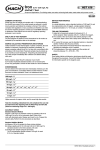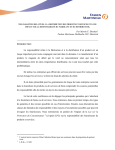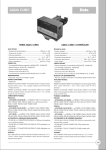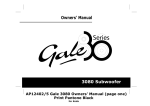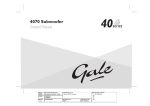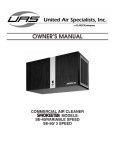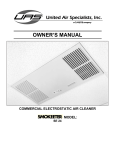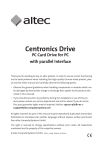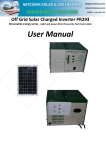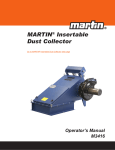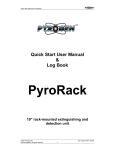Download KX1671/2 - Dust Filter Controls
Transcript
Product Data Sheet KX1671/KX1672 DS COVER CONTROLLERS Models 3, 5, 10 Way - 110Vac and 24Vdc FUNCTION - The KX1671 & 1672 Controllers are fully automatic and ensure that the diaphragm valves of the Dalamatic, Sintamatic, Siloair or Unicell dust filters are operated in sequence at regular intervals to facilitate the efficient cleaning of the filter elements. The duration of each pulse must be set to suit the type of dust filter being served and should not be altered. The interval between pulses is variable and may be altered to suit operating requirements. Circuit Control Technology 48 Boston Road Gorse Hill Industrial Estate Beaumont Leys, Leicester, LE4 1AA Tel: +44 (0) 116 2998000 Fax: +44 (0) 116 2998001 E-mail: [email protected] Contents Function Operating Range Installation Wiring/Switch Fuse Controller Protection/Operation Controller Installation Settings Optional Functions Fault Finding Technical Drawings CCT REV.C/29.02.2012 -1- 1 2 2 2 2/3 4 5 5 6/7 OPERATING RANGE 110Vac controllers are suitable for operating on a 2-wire ac supply, 50 to 60 Hz. On all models output voltage to the solenoid valve at each outlet will produce 15VA at 110V. 24Vdc controllers require a 2-wire 24Vdc supply. The output voltage to the solenoid valve at each outlet will produce 20Watts (or on 10-way modela only 60 Watts**) at 24Vdc. Temperature limitations for all controllers are -10deg.C to +60deg.C. **Up to 4 banks of “Cased-type” filters may be operated by one 10-way controller by virtue of its higher power rating. To achieve this connect the controller in parallel to the adjacent bank(s) to be served. Each slave bank has a terminal box, fitted with solenoid valves but no PCB. By this means any one output pulse from the 10-way controller will operate the corresponding solenoid valves on all such interconnected banks simultaneously. INSTALLATION On Siloair filters or Dalamatic and Sintamatic Unit or cased filters, according to the model, the controller is normally fitted above, on or below the compressed air manifold. On Dalamatic and Sintamatic Unit Concept filters, the controller is normally fitted on the base section, connected to a separate box (or boxes) containing the solenoid valves located in a chamber at the top of the filter. On Unicell filters, the controller is normally fitted below the filter section, connected to a separate box (or boxes) containing the solenoid valves located in the “clean-side” of the filter section. On Dalamatic or Sintamatic Insertable filters, the controller is normally fitted on either side of the filter body but may be remotely mounted provided not more than 1800mm of nylon tube is used to connect any one solenoid valve to its corresponding diaphragm valve. For fuller details refer to the DCE User Manual for the particular DCE filter. WIRING Prior to energising the controller, care should be taken to ensure that the correct voltage has been selected. SWITCH FUSE A fused isolator, fitted with a 3 Amp fuse at the correct input voltage rating, should be fitted between the controller and incoming supply. A high rupturing capacity (HRC) cartridge-type fuse must be used. CONTROLLER PROTECTION - PCB FUSE Protection against an output current overload is achieved by a small HRC cartridge fuse mounted on the PCB, labelled “F1”. In an emergency a quick-acting fuse could be used as a temporary alternative but a time delay fuse must not be used under any circumstances. -2- PCB Fuse Specification Size : 20mm x 5mm Rating : For all models 1 Amp (110Vac) or 3 Amp (24Vdc). Type : High rupturing capacity. Conforms to BS4265 and IEC127 sheet 1. The EEC technical description, if required, is “Grand pouvoir de coupure”. CONTROLLER OPERATION Normally, with a voltage established to the PCB, either directly or via the transformer, light emitting diodes (LED’s) L11 and L12 are permanently lit - compare with P operation. After an initial delay of approximately 20 seconds the timer circuit produces dc pulses to switch the triacs (or, on 24Vdc types, transistor output devices) in sequence. The PCB input voltage then energises the associated solenoid valve. Appropriate LEDs (L1-L10) will flash with each triac or transistor pulse, thus indicating that the controller circuit is producing the pulses. The cleaning cycle will continue until power to the controller is switched off or until one of the optional “ P” or “Int.” functions is activated. Both pulse duration and interval must be pre-set to suit the specific Dalamatic, Sintamatic, Siloair or Unicell dust filter being served (see Tables 1 and 2). Pulse duration must be pre-set in milliseconda by means of the switch marked “SET DUR” and “200/110/60”, in accordance with Table 2. Once made, this setting should not be altered. The interval between pulses is set by turning the control Knob marked “set interval” clockwise to increase the time or anticlockwise to reduce it, as indicated by the curved white symbol, and using a watch or clock to measure the seconds. The recommended initial setting is shown in Table 2, but may be varied empirically (Range : 5-35 secs.). The number of outputs (solenoid valves) to be fired is selected by the switch marked “SET OUT” and “3/5/10”. Setting “3” will allow outputs 1-3 to pulse sequentially. Setting “5” selects outputs 1-5 only. Setting “10” will fire all outputs. Table 1 - DUST FILTER IDENTIFICATION Significant Characters* DU... SU... D..... DX... S..... DLM../../10 DLM../../15 DLM X../../26 SC... DLM V... or DLM SV... SI..... VS... C..... Type of Filter Dalamatic “Unit” series DU Sintamatic “Unit” series SU Dalamatic “Unit Concept” series D Dalamatic Excel “Unit Concept” series Sintamatic “Unit Concept” series S Dalamatic “Cased” series DLM10 Dalamatic “Cased” series DLM15 Dalamatic Excel “Cased” series DLM X Sintamatic “Cased” series SC Dalamatic “Insertable” series DLM V Sintamatic “Insertable” series CS1 Siloair series VS Unicell series C *As stamped on “MODEL” panel on Serial no. nameplate, mounted on outside of Filter -3- Table 2 - CONTROLLER INSTALLATION SETTINGS Pulse Duration (Fixed) ms Interval (Variable) secs Unit Concept (series D and DC) All models 110 12 Unit (series DU) Models DU7, 10, 14 and 20 Models DU30 and 45 200 110 25 12 200 25 110 12 Cased (series DLM 10) All models 60 12 Cased (DLM 15 and DLM X) All models 110 12 Unit Concept (series S) All models 110 12 Unit (series SU) All models 110 12.5 Insertable (series CS1) All models 110 12.5 Cased (series SC) All models 110 12 200 12 200 12 Filter type Dalamatic Insertable (series DLM V) Models V3/7, 4/7*, 5/12* 6/10*, 7/7*, 7.5/12*, 8/7* 9/15*, 10/10*, 12/10*, 13/12* 14/7*, 15/12*, 15/15*, 18/15* and 20/10 (5-valve version) Note: All of these normally have dual-element cleaning i.e. two jet tubes per valve. Alternatively, those marked with an asterisk (*) may have single element cleaning i.e. one jet tube per valve, settings for which are: Sintamatic Siloair (Series VS) - All models Unicell (Series C) - All models -4- OPTIONAL FUNCTIONS 1. Differential Pressure ( P) A P function is incorporated into the PCB for use in conjunction with a Differential Pressure Switch to control the cleaning cycle of DS Cover Controller(s) on Dalamatic installations. It is not suitable for use with Sintamatic, Siloair or Unicell filters. Tappings for the differential pressure switch are taken from the clean and dirty sides of the dust filter. For more information refer to SCS drawings KX63000, KX64001, PS0200 and/or PSI.200, whichever is or are applicable.. P Operation When a DS Cover Controller is governed by a differential pressure switch, LED L11 only will be permanently lit. Once a signal from the pressure switch is received L12 will also light up and if the signal continues without interruption for a minimum of 20 seconds the )P circuit will be initiated. a normal cleaning cycle will follow, LED’s flashing with each pulse. If the pressure switch signal ceases during the cycle, L12 will go outbut the cycle will be completed, leaving the controller reset ready for the next signal. If the pressure switch remains open a further cycle will commence, and so on. 2. Intermittent (Int.) This function is primarily intended for interlocking with other associated controls such as the fan starter. With a normallly closed (NC) contact connected to these terminals, LED’s L11, L12 and L13 will be lit. When the contact opens. e.g. upon energisation of the fan or blower, L13 will go out and the timer circuit will be initiated. Normal cleaning cycles will follow, output LED’s flashing with each triac or transistor pulse. When the contact closes again, L13 will light up and the cleaning pulses will stop immediately. Upon receiving the next signal the contact will re-open and the cleaning cycles will continue, starting from the next triac or transistor in sequence. DUST FILTER OPERATION Important: Before starting up any equipment, refer to the User Manual specific to your dust filter and carefully follow the instructions given under the headings“Installation” and “Commissioning”. When making your preliminary checks, or during the start-up sequence, particularly note that on filters fitted with an explosion panel the cleaning system should not be operated on its own for longer than necessary as the pressure produced could weaken the Membrex membrane. FAULT FINDING 1. Fuses In the event of DC Cover Controller failure, first check that the switch fuse is intact and that the correct electrical supply is connected to the appropriate terminals. If it is and LED L12 is not lit, check the HRC fuse mounted on the PCB and replace it if necessary. Fuses will tire and fail over time and vibration may also shorten their working life. Routine replacement of the fuse is recommended to prevent filter breakdown due to fuse failure. 2. Output Triacs (or Transistors) The triacs (or transistors) are situated adjacent to the output terminals on the edge of the PCB and labelled T1, T2 etc. They are reliable devices and in many ways self-protecting but when misused or in some way defective they usually fail to “close circuit”. This may be detected easily because the associated solenoid valve will be continually energised and will often overheat. If a replacement PCB Assembly is not available and it is important to keep the dust filter running it is possible to do so with the defective output disconnected untill a new board can be fitted, but a careful watch must be Kept on Dalamatic, Sintamatic, Siloair or Unicell filter performance. -5- -6- -7-







